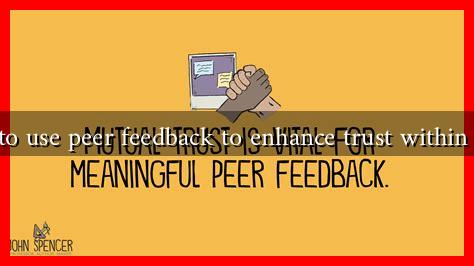-
Table of Contents
- How to Use Peer Feedback to Enhance Trust Within Teams
- The Importance of Trust in Teams
- What is Peer Feedback?
- Strategies for Implementing Peer Feedback
- 1. Create a Safe Environment
- 2. Train Team Members
- 3. Encourage Regular Feedback
- 4. Recognize and Celebrate Growth
- Case Study: Google’s Project Aristotle
- Conclusion
How to Use Peer Feedback to Enhance Trust Within Teams
In today’s fast-paced work environment, fostering trust within teams is essential for collaboration, innovation, and overall productivity. One effective method to build this trust is through peer feedback. When implemented correctly, peer feedback can create a culture of openness and support, leading to stronger relationships among team members. This article explores how to effectively use peer feedback to enhance trust within teams.
The Importance of Trust in Teams
Trust is the foundation of any successful team. According to a study by the American Psychological Association, teams with high levels of trust are more likely to achieve their goals and maintain high morale. Trust encourages open communication, reduces conflict, and fosters a sense of belonging. Here are some key benefits of trust in teams:
- Improved Communication: Team members feel safe sharing ideas and concerns.
- Increased Collaboration: Trust leads to more effective teamwork and cooperation.
- Enhanced Problem-Solving: Teams can tackle challenges more creatively when they trust each other.
- Higher Engagement: Employees are more likely to be committed to their work when they trust their colleagues.
What is Peer Feedback?
Peer feedback is the process of providing constructive criticism and praise among colleagues. Unlike traditional top-down feedback, peer feedback encourages a two-way dialogue that can lead to personal and professional growth. It can take various forms, including:
- Formal Reviews: Scheduled sessions where team members provide feedback on each other’s performance.
- Informal Conversations: Casual discussions that allow for spontaneous feedback.
- 360-Degree Feedback: Comprehensive feedback from all directions, including peers, supervisors, and subordinates.
Strategies for Implementing Peer Feedback
To effectively use peer feedback to enhance trust within teams, consider the following strategies:
1. Create a Safe Environment
For peer feedback to be effective, team members must feel safe to express their thoughts. This can be achieved by:
- Establishing ground rules for feedback sessions.
- Encouraging a culture of respect and openness.
- Leading by example; leaders should also seek and accept feedback.
2. Train Team Members
Providing training on how to give and receive feedback can significantly improve the quality of interactions. Training should cover:
- How to frame feedback constructively.
- Active listening techniques.
- How to handle defensive reactions.
3. Encourage Regular Feedback
Feedback should not be a one-time event but rather an ongoing process. Encourage team members to:
- Schedule regular feedback sessions.
- Incorporate feedback into daily interactions.
- Use tools like anonymous surveys to gather honest opinions.
4. Recognize and Celebrate Growth
When team members act on feedback and show improvement, it’s essential to recognize their efforts. This can be done by:
- Publicly acknowledging achievements in team meetings.
- Creating a “kudos” board where team members can share positive feedback.
- Offering incentives for those who actively participate in the feedback process.
Case Study: Google’s Project Aristotle
Google’s Project Aristotle, a study on team effectiveness, found that psychological safety—where team members feel safe to take risks and be vulnerable—was the most important factor in building successful teams. By implementing peer feedback mechanisms, Google fostered an environment where employees felt comfortable sharing their thoughts, ultimately enhancing trust and collaboration.
Conclusion
Using peer feedback to enhance trust within teams is a powerful strategy that can lead to improved communication, collaboration, and overall team performance. By creating a safe environment, providing training, encouraging regular feedback, and recognizing growth, organizations can cultivate a culture of trust that benefits everyone involved. As teams become more cohesive and supportive, they are better equipped to tackle challenges and achieve their goals. For more insights on building trust in teams, consider exploring resources from the American Psychological Association.

